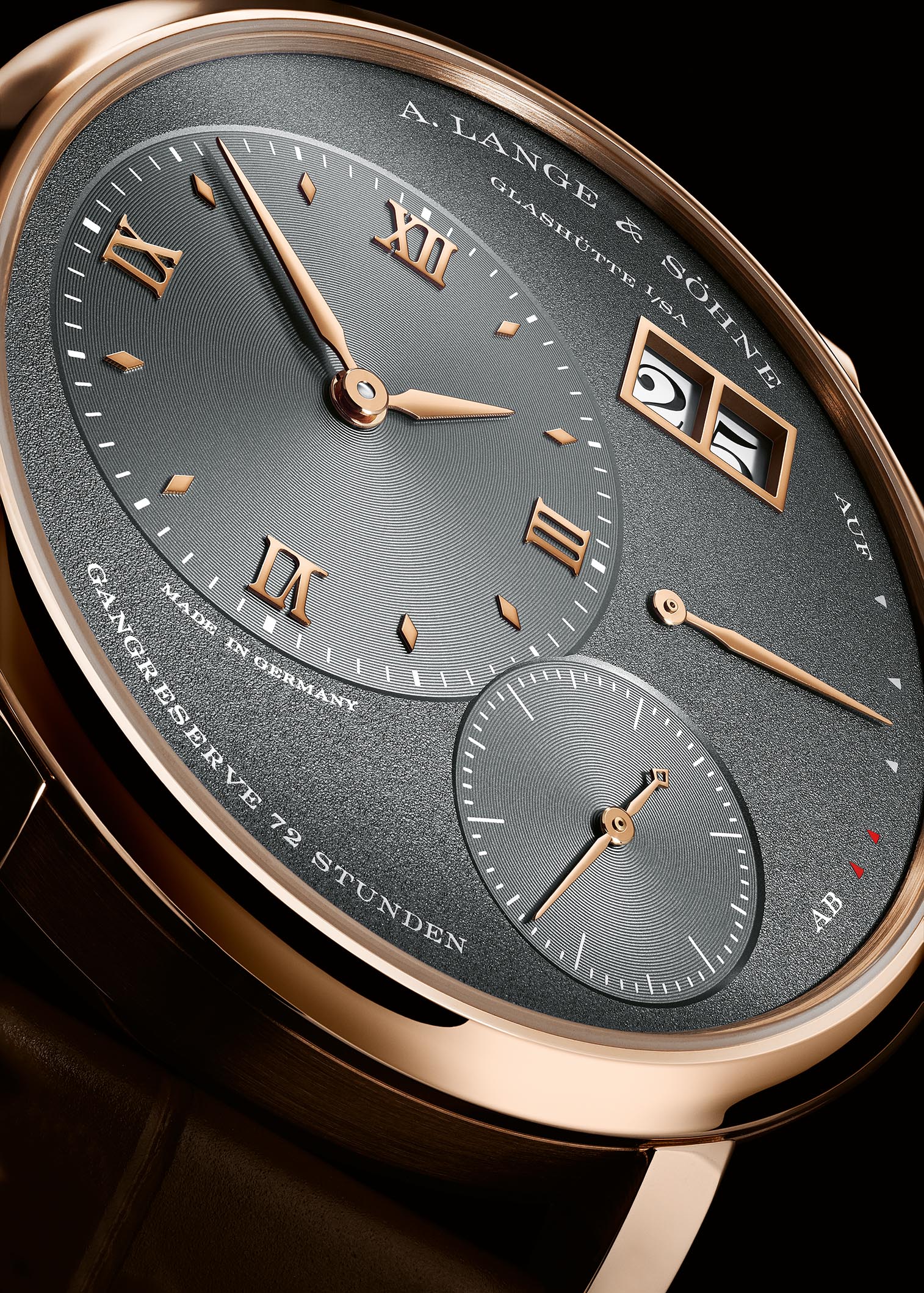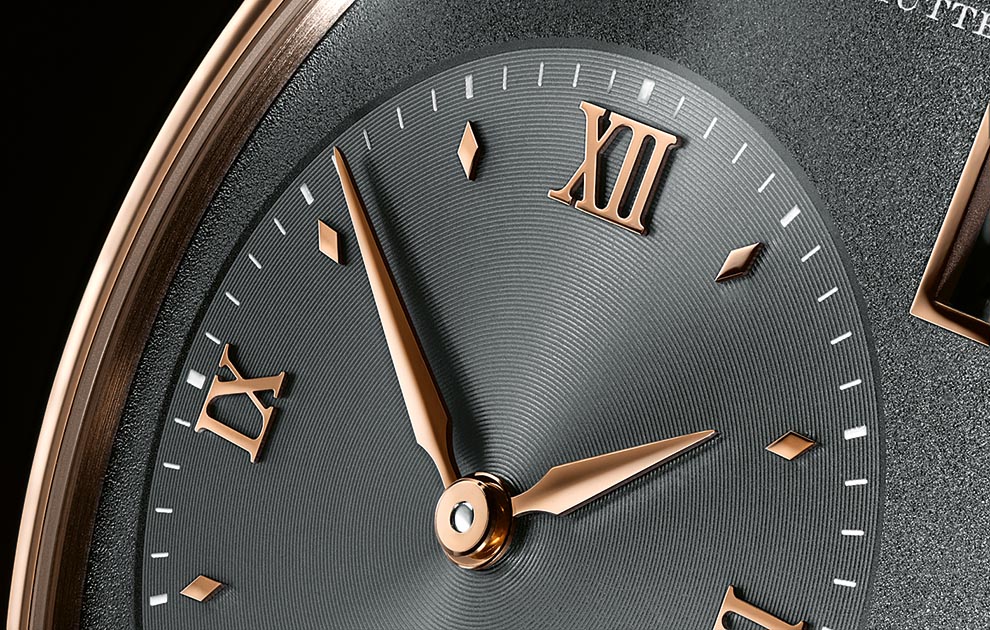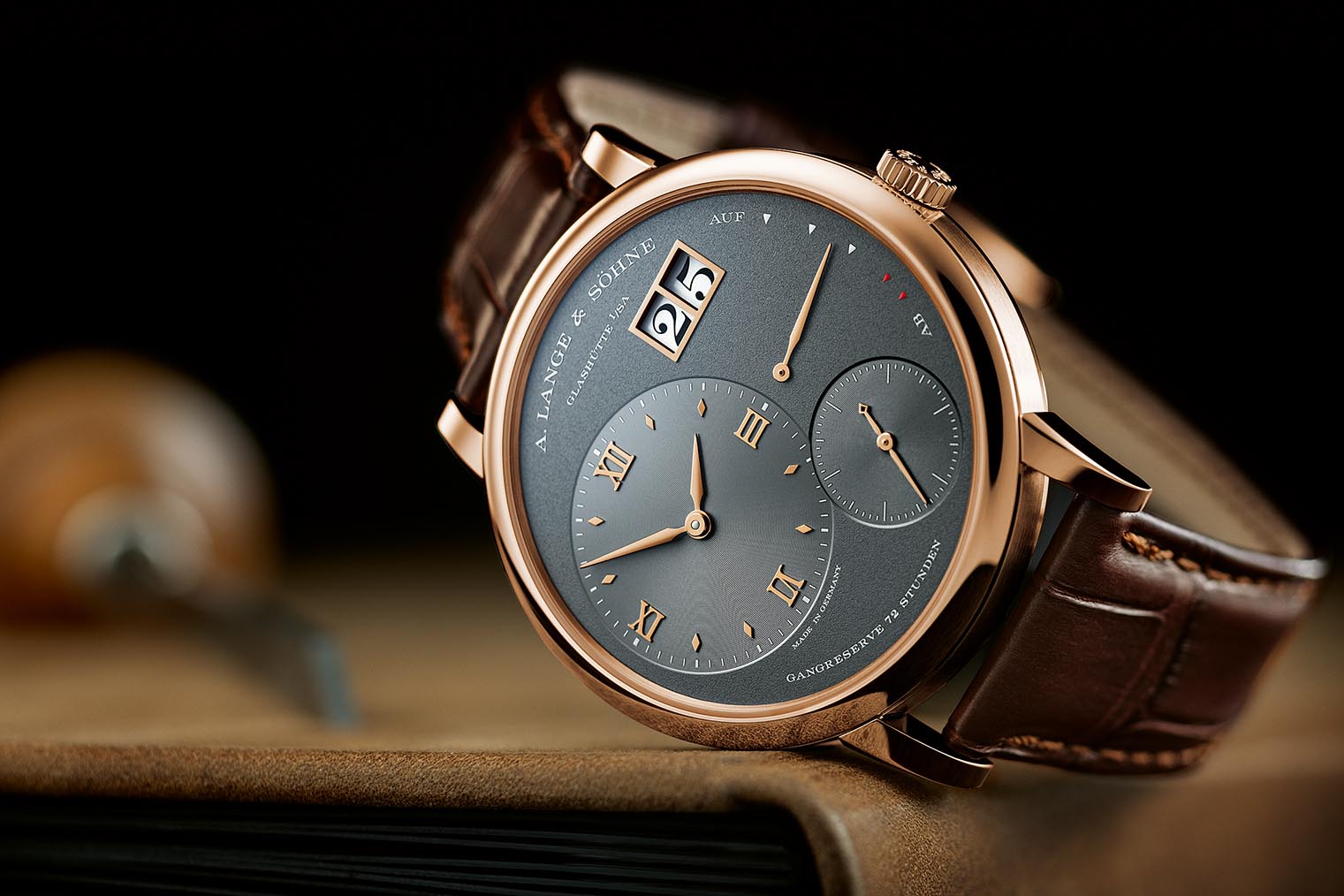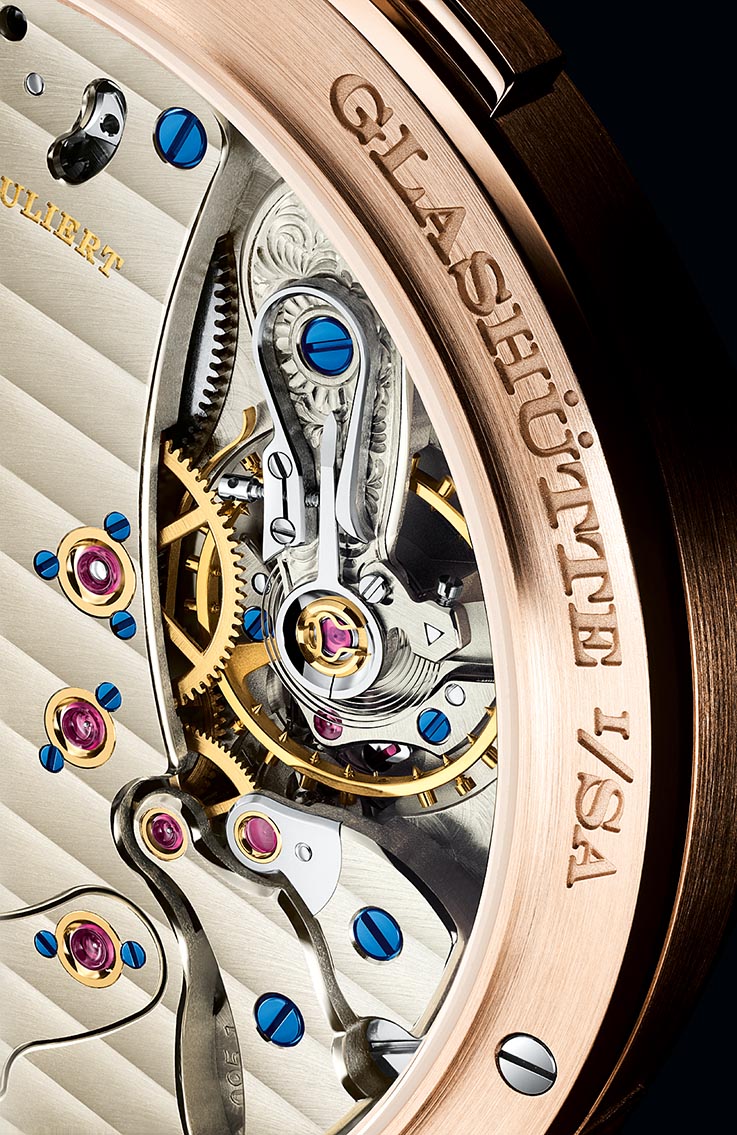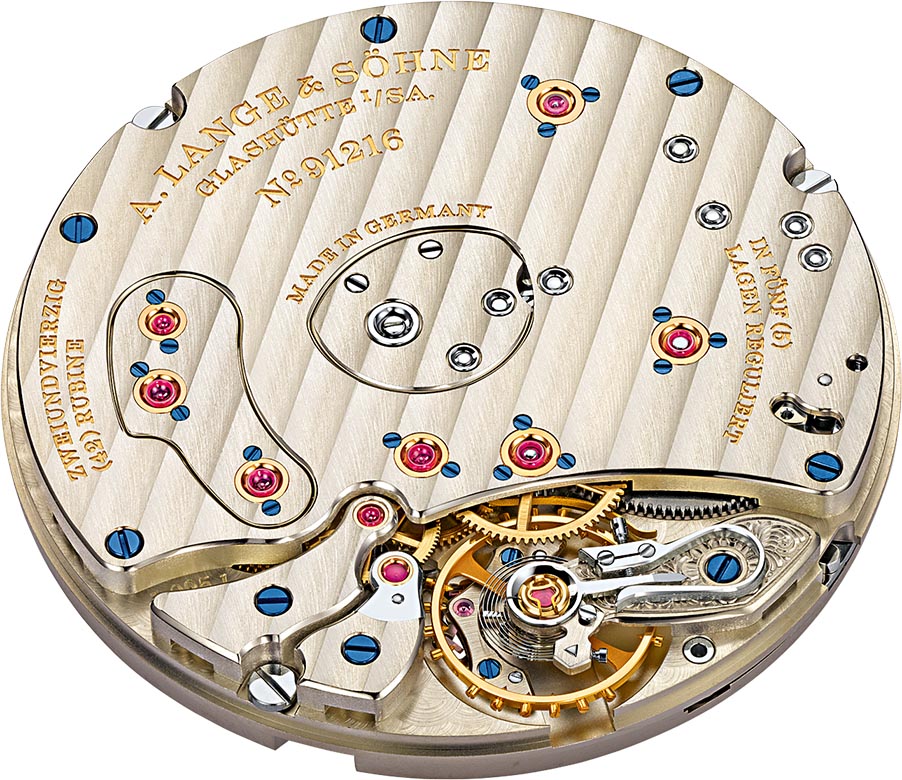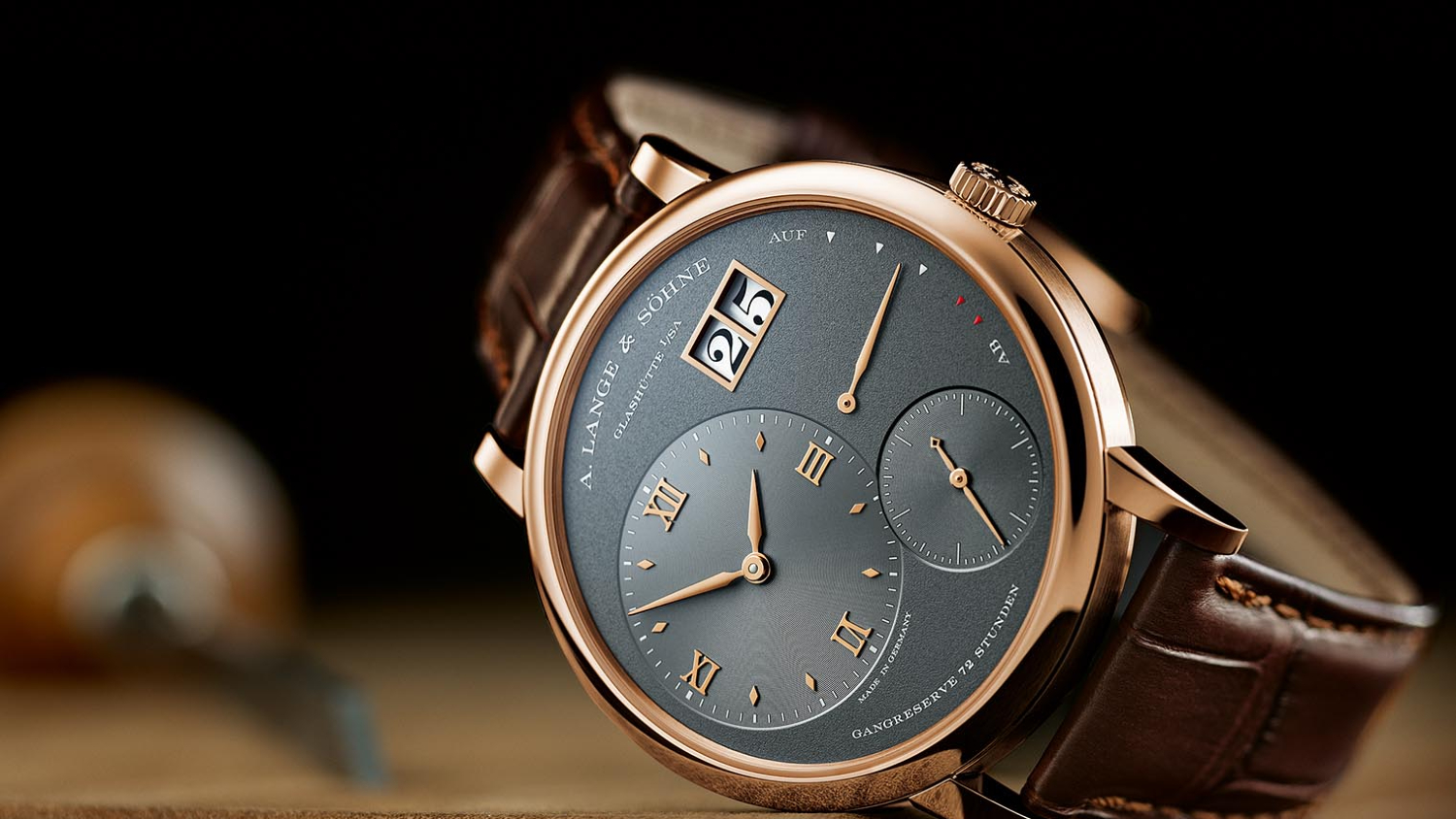With its 41mm rose-gold case, the Grand Lange 1 honours its namesake Lange 1, presenting an extremely elegant appearance with its anthracite-coloured dial and slimmer height of only 8.25mm. It lies snugly on the wrist on a red-brown, hand-stitched leather strap with a matching, classic pin buckle in rose gold. Thanks to perfectly sloping ergonomic lugs, it lies very comfortably, even on smaller wrists. It reveals its full grandeur in numerous well-thought-out details, even though not all of them are immediately visible. The Grand Lange 1 became an established member of the collection in 2003 and was given its own movement in 2012, which continues to do its job 10 years later in this edition launched in 2022.
The history of the Grand Lange 1 actually begins with the introduction of the Lange 1 on October 24, 1994. It caused quite a stir with its offset dial layout, 3-day movement, and the first outsize date in a production wristwatch. Like a Porsche 911 or a Bauhaus chair, it has become a classic, and undoubtedly one of the most famous examples of German watchmaking in the world due to its almost unchanged design and high recognition factor. Even when it grew in size to become the Grand Lange 1, complications like the moon-phase, second timezone, or the combination of a tourbillon and perpetual calendar enriched the spectrum and were sometimes reflected on the dial. Both the Lange 1 and the Grand Lange 1 have remained recognisable by retaining every design element.
Unmistakable Design Makes the Lange 1 a Classic
The watch family currently comprises 10 models: Lange 1, Lange 1 Moon Phase, Grand Lange 1, Grand Lange 1 Moon Phase, Small Lange 1, Small Lange 1 Moon Phase, Lange 1 Daymatic, Lange 1 Time Zone, as well as the Lange 1 Perpetual Calendar and Lange 1 Tourbillon Perpetual Calendar. Each model, including our test watch—the 2022 Grand Lange 1 in rose gold—features Lange’s signature outsize date. Seen from this point of view, the history of this famous watch goes back much further. The design of the gold-framed double window was inspired by the famous Five-Minute Clock in the Dresden Semper Opera house, whose first introduction was the installation in 1841 above the stage by the Dresden court clockmaker Johann Christian Friedrich Gutkaes, supported by his partner and son-in-law Ferdinand Adolph Lange. It’s a fitting tribute to an important clockmaker and the namesake of the brand.
The Lange outsize date offers a display that is about three times the size of date displays on other watches with comparable dimensions. To achieve the largest possible date display in a limited space, the mechanism works with two separate display areas: The ring-shaped single-digit disc (with the numerals 0 to 9) advances once per day. It remains in place for the date change between the 31st and the 1st. The cross-shaped component for the tens digit (with the numerals 1 to 3 and a blank white field) moves ahead one position only every 10 days. Only the 3 advances after two days to the next (blank) field.
This already sounds like a minor complication. Ensuring that the 32nd does not follow the 31st of the month, but instead advances automatically to the 1st of the new month, requires a complex calendar mechanism with 66 individual parts. Each display disc has its own program wheel with a special tooth configuration to ensure correct advancement. A distance of only 0.15mm separates the ones disc and the tens cross that sits above it. Extreme dexterity and care are needed during the assembly stage of this highly refined mechanism, one that can easily be categorised as a complication.
A Big Show During the Date Change
When the movement is running, the visible advancement of the date begins about 10 minutes before midnight, with the date jumping to its next position about 20 minutes after midnight. If both discs must advance—from the 19th to the 20th day of the month, for example—they will jump together into their new positions about 20 minutes after midnight. Correcting the date at the end of a short month—for example, advancing the date from the 30th to the 1st of the next month—is performed by pressing a rectangular, bevelled pusher on the left side of the case at 10 o’clock. This switching process is problem free and has a rich feel.
While the Lange outsize date is steeped in history, it is just one of the model-defining features of the Grand Lange 1. I would say that every other display on the 35mm dial is just as remarkable and expressive. The offset layout follows the geometrically balanced proportions of the design rules laid out by the golden ratio and specific spatial relationships that form the exceptional harmony of the Grand Lange 1.
In the golden ratio, two variables are proportionate when the relationship of the whole to the larger portion corresponds to the relationship of the larger portion to the smaller part. Expressed numerically, this is a ratio of 1 to 1.618, and it has appeared in the work of Leonardo da Vinci, Le Corbusier and others.
Grand Harmony
The anthracite-coloured dial of the Grand Lange 1 reflects the relationship of the Golden Ratio in two ways—in the relationship of the overall dial diameter to that of the decentralised hour and minute subdial, and in the proportions of the width and height of the date windows. In addition, the centre bar separating the two oversize date display windows is arranged along a vertical line with the axes of the small seconds subdial and the power reserve pointer on the right side of the dial. If you were to draw an imaginary line through the midpoints, and to the centre point of the hour and minute hand, this would create an isosceles triangle. And, the centres of the hour and minute hands and the power reserve pointer lie along a horizontal line extending from 3 to 9 o’clock.
Closer inspection of the grey dial on its solid silver plate reveals several more design features. For example, note the delicate bevels that provide harmonious transitions between the concentric grooves of the subdials for the time display and the small seconds and the grained main dial, or the gently touching dials of the hours and minutes and the small seconds. While the small seconds dial is neatly printed, the recessed time display subdial gives the four gold Roman numerals and eight applied diamond-shaped hour markers a 3D appearance, even though they are all quite flat. The hands circling above have a classically elegant look and can be set precisely using the crown, without any play. And for the well-known Lange AUF/AB (Up/Down) power-reserve display, nothing is left to chance: When the watch has run down, the long slender hand will be positioned directly on the periphery of the small seconds subdial, and when fully wound, on the last triangular marking of the power-reserve display.
This special type of power-reserve indication also has a story to tell. On May 18, 1879, A. Lange & Söhne received Patent No. 9349 from the German patent office for a “device in pocket watches to distinguish whether the watch is fully wound or run down, and for indicating how much time is remaining until it is run down.” It is the official birth date of the iconic Lange AUF/AB (Up/Down) power-reserve indication, which would later be adopted by other Glashütte watch brands and continue until today, based on this patent description.
The words ‘Gangreserve 72 Stunden’ (Power Reserve 72 Hours), rendered in fine lettering, are arranged in an arc along the edge of the main dial. The power is provided by hand-wound Caliber L095.1, the same movement that was already used in the Grand Lange 1 by the year 2012. This also allowed the case thickness of 11.0mm to be reduced to 8.8mm. Subsequent detailed work reduced it still further by another 0.6mm. Compared to its 2012 predecessor, the diameter remained unchanged, but it shrank 10 years earlier from the 41.9mm of the original model to exactly 41mm. With Caliber L095.1, it was possible to create a dial layout without any overlap of the displays for the time, outsize date, and power reserve—just like the Lange 1—with larger proportions extending outward while still retaining the design codes of the collection. In contrast to hand-wound Caliber L121.1 in the Lange 1, with its double winding barrels with two stacked mainsprings, the L095.1 has only a single barrel. Its larger diameter permits a maximum power reserve of 72 hours and contributes to the overall slim height of the Grand Lange 1.
Top Form Beneath the Sapphire Crystal Caseback
Hand-wound Caliber L095.1 completely fills the case beneath the flat sapphire crystal. It is composed of 397 individual components, including 42 jewels, seven of which are set in highly polished gold chatons, secured with blued screws. These are just as much a recognisable feature of the Glashütte architecture as the solid three-quarter plate made of untreated, gold-tinged German silver. The movement is built and assembled twice according to the highest Lange quality criteria, decorated and finely adjusted in five positions, and it runs with well-balanced rate results. On the timing machine, it gained 4.4 seconds per day when fully wound, and only 3.2 seconds after 24 hours of running time without additional winding. It was even more impressive on the wrist, showing an average gain of only 1.3 seconds per day.
An interplay of colour unfolds through the use of various materials and finishes, with the crowning achievement formed by the classic screw balance with Lange hairspring beneath the hand-engraved balance cock. It is said that individual artists can be identified on the basis of each engraving, making every Grand Lange 1 a unique timepiece.
Images: Courtesy Brand
